VP - 303.720.7969
25 States, from Alabama to Missouri
![alabama[1].gif](https://static.wixstatic.com/media/aee4d7_2cc869b9ef7648859c798c79677ca0c9~mv2.gif)
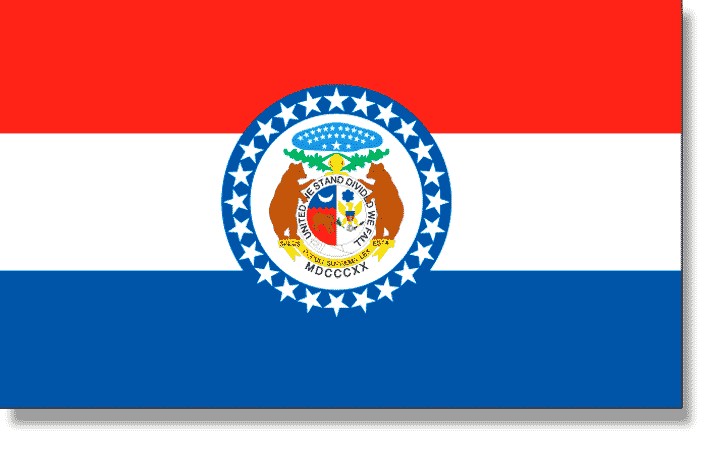
The crimson and white colors of the Alabama flag were officially adopted in the year 1895 by the Alabama legislature. The flag has two crimson bars in an X pattern that is similar to the St. Andrews Cross. There has been much debate since the creation of the flag over whether or not it is supposed to be rectangular or square shaped. It was not until 1987 that this matter was settled by then Attorney General Don Siegelman, who determined that since the flag had been reproduced so many times in the shape of a rectangle that it should continue in that manner from that point onwards.
![alabama[1].gif](https://static.wixstatic.com/media/aee4d7_c7e570a3c8d546e5bac32fc3f4cd54f4~mv2.gif)
The dark blue flag of Alaska was originally created in 1927 by thirteen year old John Bell Benson who submitted his design as part of a state-wide contest. Young Bensons’ flag beat out 142 other entrants, most of which are on display at the Alaska Historical Library & Museum. This beautiful flag contains eight gold stars, seven of which form the Big Dipper and the eighth is representative of the North Star.
![alaska[1].gif](https://static.wixstatic.com/media/aee4d7_e20ea5a0185e4fc9b5a5022292b5f603~mv2.gif)
The magnificent setting sun flag of Arizona incorporates symbolism from both the past and the present. The yellow and red alternating stripes represent the original thirteen colonies and the star in the middle of the flag is copper in color to show Arizona’s status as the country’s largest producer of copper even today. The colors utilized are also symbolic, with the red and blue being the state colors of Arizona while the red and yellow are reminiscent of the Spanish influence on the state.
![arizona[1].gif](https://static.wixstatic.com/media/aee4d7_052b2f782edf4874bfc8d8a72aa2588c~mv2.gif)
Arkansas’s red, white, and blue flag is filled with the history of the state. The large blue diamond encompassing the artwork stands for the fact that Arkansas is the countries only diamond-producing state. There are 25 white stars within the blue diamond which account for Arkansas being the 25th state to be admitted into the union. The three blue stars at the bottom of the flag represent the three countries that controlled the state throughout its history: France, Spain, and the United States. The two parallel blue stars are symbolic for both Arkansas and Michigan, which were admitted at the same time in 1836. The star at the top of the flag stands for Arkansas role in the Confederacy during the Civil War.
Arkansas’s red, white, and blue flag is filled with the history of the state. For example, the 25 white stars within the blue diamond account for Arkansas being the 25th state to be admitted into the union.
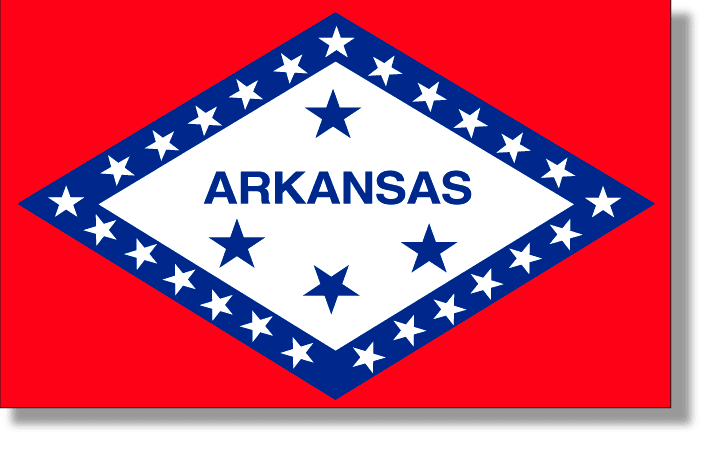
The captivating flag of California was originally used to declare their independence from Mexico in 1846. Quickly designed and built with materials they had available, the settlers raised the flag at the Mexican garrison in Sonoma after taking the commander there as prisoner and the flag declared the land as “California Republic.” The other symbols on the flag include the grizzly bear, which stands for strength, and the red star, which is representative of the “Lone Star” of Texas. The California legislature officially declared this as the state flag in 1911.
![california[1].gif](https://static.wixstatic.com/media/aee4d7_7df313ec4b1644d1b94857180929058d~mv2.gif)
Colorado’s state flag was designed with the state’s natural beauty in mind. This handsome flag was originally created in 1911 by Andrew Carlisle Johnson who used each color in the flag to stand for a different Coloradan theme: the blue symbolizes the clear blue skies, the white is used to represent the snowcapped mountains, the red pertains to the color of the earth throughout the state, and the gold stands for the sunshine that the state receives.
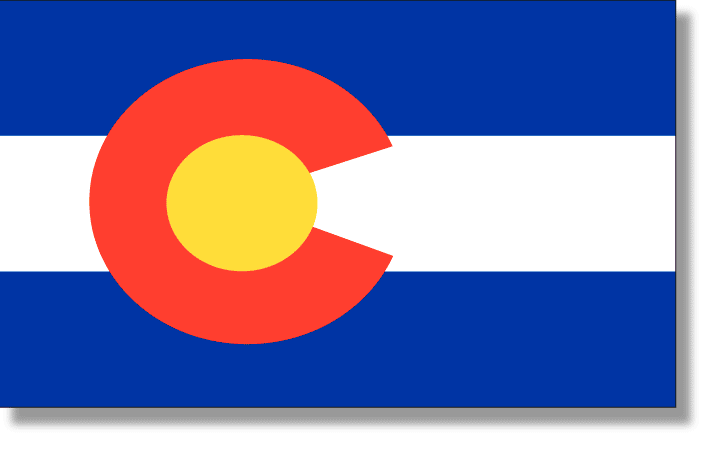
Up until 1897 Connecticut did not have an official state flag. Citizens of CT can thank Abby Day who lobbied the state legislature relentlessly until she achieved her goal of making sure that a state flag was created. This blue flag contains a white shield with three grapevines on it, which stand for religion, liberty, and knowledge as well as the original three colonies of Connecticut Hartford, Windsor, and Wethersfield. Below the shield is the state motto “Qui transtulit Sustinet' - 'He who hath transplanted will sustain.”
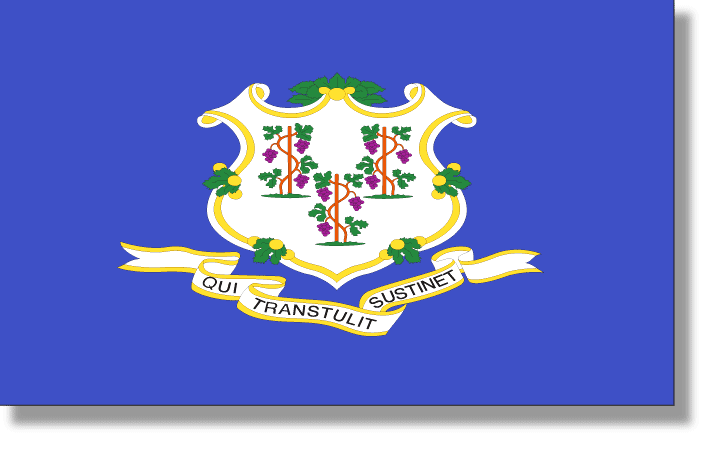
Even though the date December 7, 1787 appears on the flag of Delaware, it was not until July 24th 1913 that their state flag was adopted. The date at the bottom of the flag is representative of the fact that they were the first state to ratify the Constitution of the USA and therefore the first official state within the Union. The diamond in the center of the flag is symbolic of Thomas Jefferson’s comment that DE is a “jewel” among the states due to its location on the eastern coast of the country. With many symbols and history on this flag, it too is a “jewel” among flags.
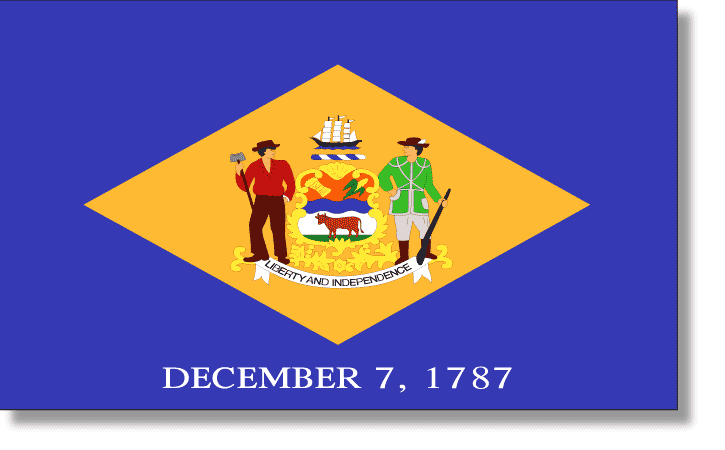
The official flag of Florida, adopted in 1900, contains a red, diagonal cross over a white background and in the center is the Seal of the state. There are several symbols on the State Seal that were updated for accuracy in 1985 including a Seminole Indian female, an enhanced steamboat, as well as a sabal palm tree. The red cross in the center of the flag, added in 1899, was suggested by the Governor at that time, Francis Fleming, to make sure that the flag did not appear to be one of surrender or truce while it is being hung on a flagpole.
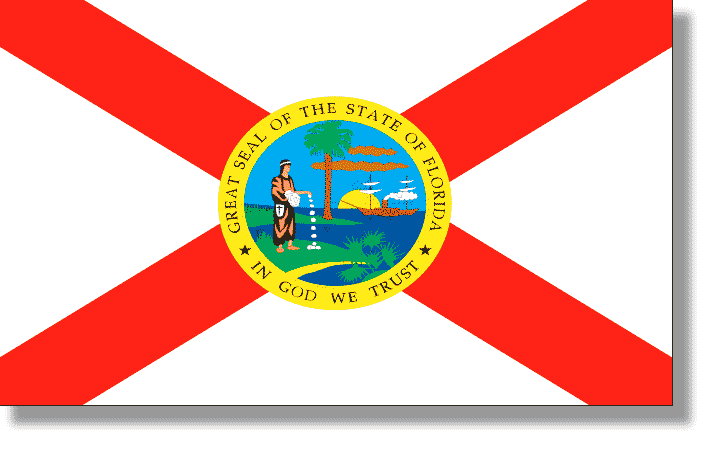
The flag of Georgia has had many different variations throughout the years and in 2003 the most recent version was settled upon. This red, white, and blue flag contains the state’s Seal and thirteen white stars. Although the Seal of Georgia has also been redesigned many times, several aspects have remained constant: the arch that is held up by the three columns, the words Wisdom, Justice, and Moderation which have always appeared on banners, and finally the soldier representing defense of the constitution have been present since the Seals inception in 1799.
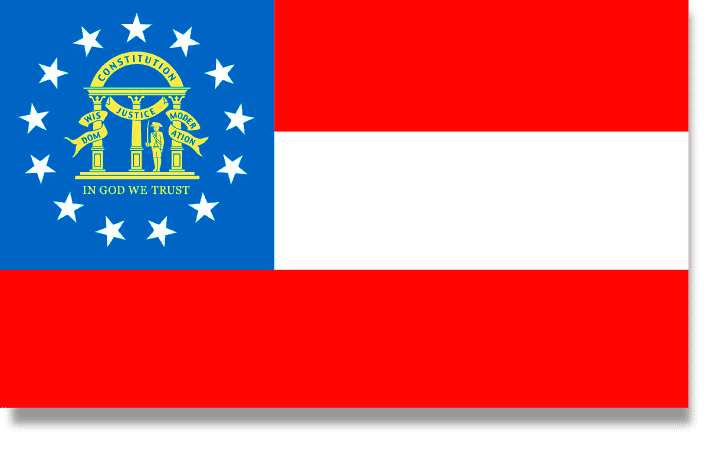
The Hawaiian flag was adopted in 1845 and combines elements of two of the most influential countries of the time: the United States of America and the United Kingdom. The Union Jack in the corner is representative of the UK, while the eight stripes signify the USA. The eight stripes also stand for the eight main islands in the chain: Hawaii, Kahoolawe, Kauai, Lanai, Maui, Molokai, Niihau, and Oahu.
The eight stripes stand for the eight main islands in the chain: Hawaii, Kahoolawe, Kauai, Lanai, Maui, Molokai, Niihau, and Oahu.
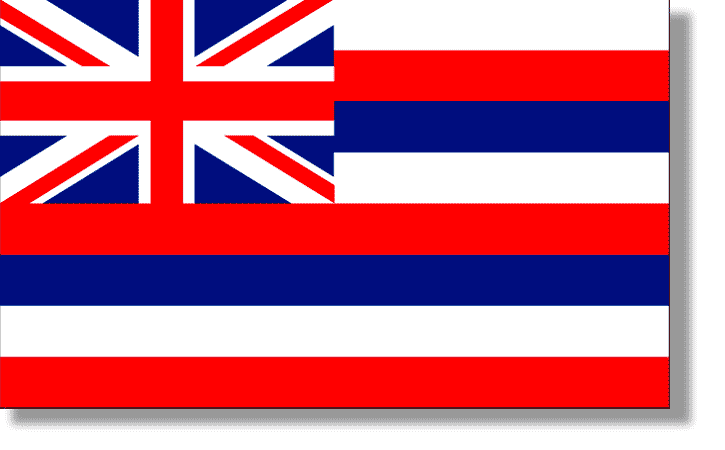
The state flag of Idaho contains the only state seal in the country that was designed by a woman, Emma Edwards. The right of women to vote was being debated at the time that she created the seal and she placed the man and woman in the seal next to one another and at equal heights. While designing the seal she spoke with many prominent citizens within the state to determine the most important symbols of Idaho. Some of the symbols include the miner, the scales (to denote liberty and justice), the trees, the shield, the stamp mill, the cornucopia, and the elk’s head.
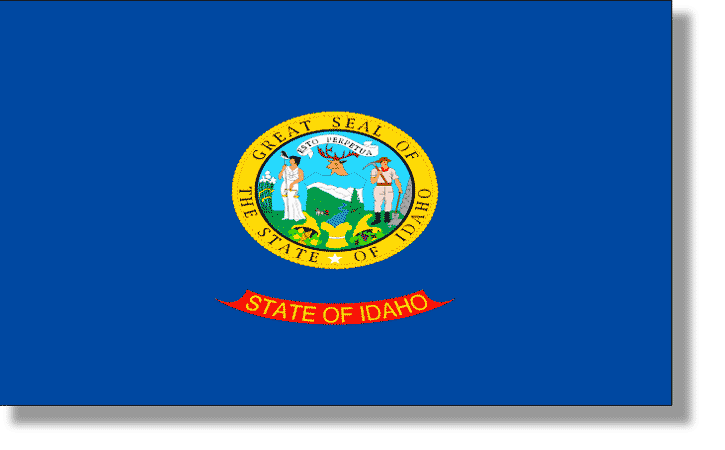
The Illinoisan flag was originally designed by the Rockford Chapter of Daughters of the American Revolution and officially adopted in 1915. Their chapter won a contest sponsored by the D.A.R. to create a state flag for IL. The bald eagle pictured on the flag is representative of the United States of America and in its beak is the state motto. The word Illinois was added to the flag during the Vietnam War because it was difficult to discern its identity.
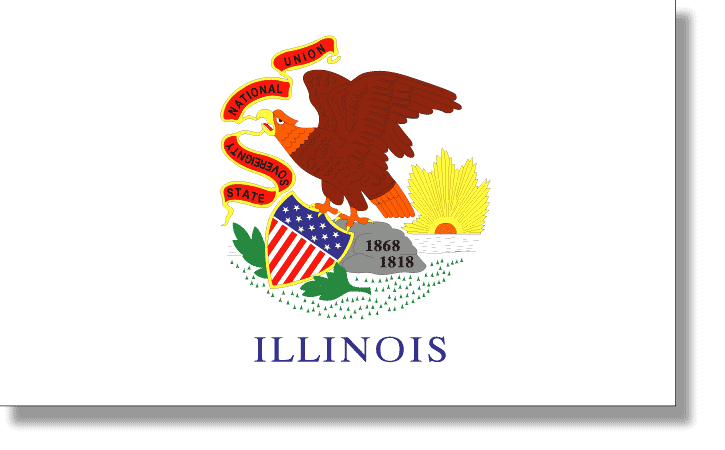
The dark blue flag of Indiana incorporates symbolism to portray the history of the USA as well as two values that Americans hold in high regard, liberty and enlightenment. The torch in the center of the flag is representative of those values, while the rays emanating from it show how their influence has spread. The thirteen outer stars stand for the original thirteen colonies and the five inner stars are a reference to the next fives states that will be brought into the Union. The largest star at the top of the flag, right below the name of the state, represents the state itself.
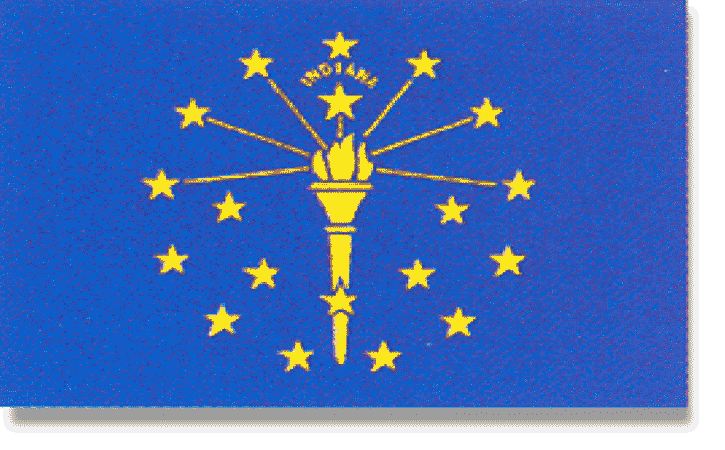
The tri-color Iowa state flag is another flag that while appearing simple in design, actually has many symbols within the flag. The creator of the flag, Dixie Cornell Gebhardt, designed it with the history of Iowa in mind. The red, white, and blue colors are representative of Iowa’s close ties to France. The white stripe in the center is indicative of the Native Americans that had roamed the land prior to it being settled by Europeans. Finally, the eagle in the center of the flag is used to symbolize Iowa’s integration within the United States of America.
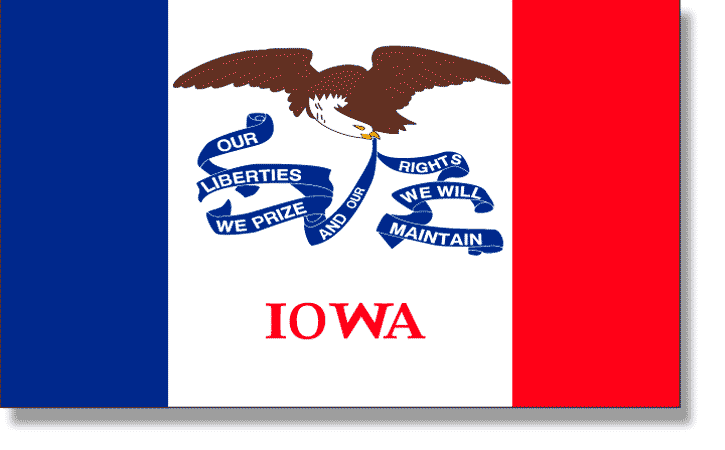
Adopted in 1927, the Kansas state flag is a dark-blue rectangle including the state seal and a sunflower. The seal, located in the center of the flag, tells the story of Kansas with its motto, “Ad Astra per Aspera,” meaning “To the Stars through Difficulties.” The thirty-four stars above the motto signify Kansas as the 34th state to be accepted into the Union. The word “Kansas” was added to the bottom of the flag in 1961.
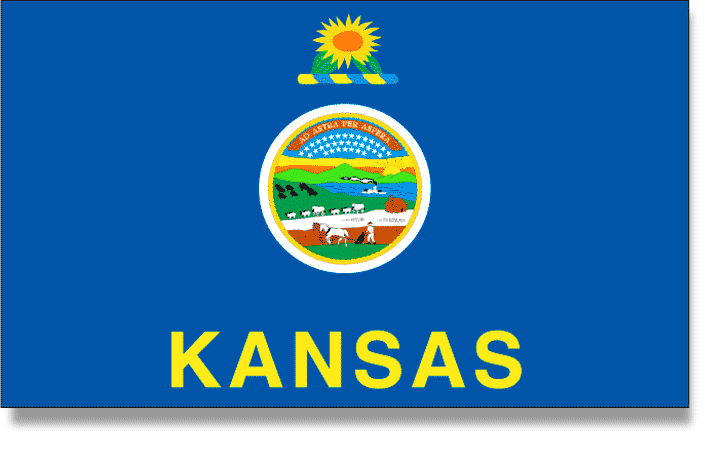
On a background of navy blue, the words “Commonwealth of Kentucky” headline the Kentucky state flag, along with two sprigs of goldenrod, the state flower. At the center of the flag, the Kentucky state seal depicts two men shaking hands, a pioneer and a statesman. The belief is that these two figures represent all men as captured in the state motto, “United We Stand, Divided We Fall.”
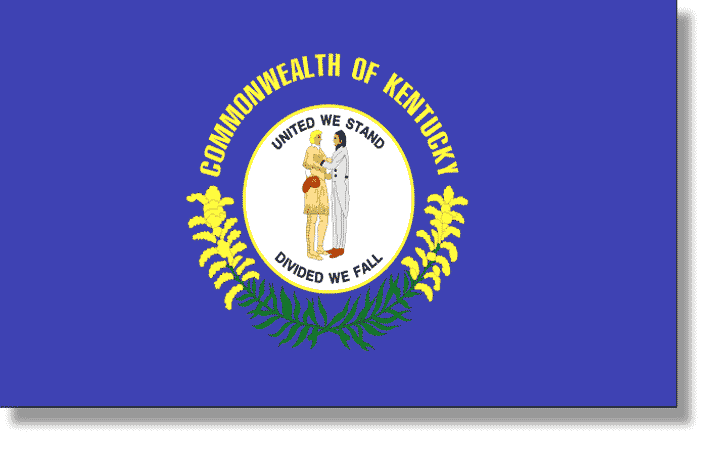
Remarkably, ten very different flags flew over Louisiana before the legislature officially adopted a state flag in 1912. Prior to the territory being purchased in 1803 by the United States from France, Louisiana proudly flew the banner of Spain, France, and Great Britain among others. Louisiana even flew a flag as an independent nation for two months after seceding from the Union in 1861. On an azure background a pelican, the state bird, feeds her three young with drops of blood gouged from her own breast, affectionately referred to as a “pelican in her piety.” Below the pelicans is Louisiana’s state motto, “Union, Justice & Confidence.”
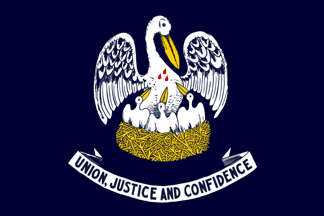
The first official flag for the state of Maine, adopted in 1901, consisted of a blue North Star shining down on a pine tree on a buff-colored background. Eight years later, the Maine legislature approved a new design, one featuring the Maine Coat of Arms on a blue field. The shade of blue is identified as the blue used in the United States flag. A farmer and a seaman represent Maine’s traditional reliance on agriculture and the sea. Above the shield and beneath the North Star is the word, “Dirigo,” the state’s motta meaning “I lead.” A banner beneath the shield bears the state’s name.
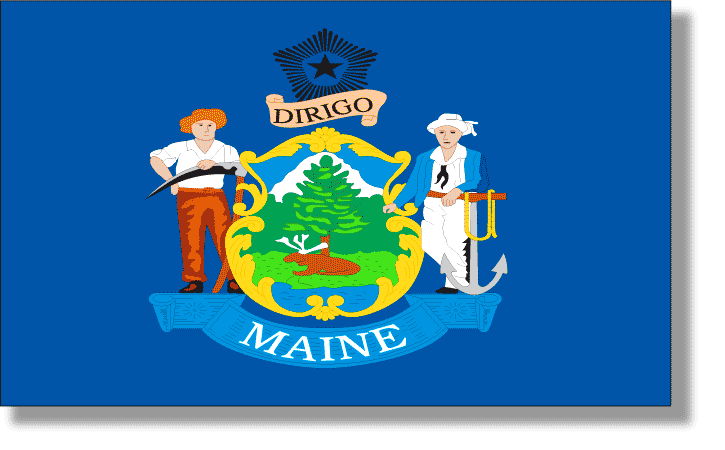
Taken from the shield in the coat of arms of the family of George Calvert, first Lord Baltimore, the Maryland state flag embodies the yellow-and-black arms of his paternal family with the red-and-white colors and cross-bottony design of his maternal family, the Crosslands. (It has been disputed that the red-and-white colors are instead from the Mynne family, the family name of the wife of George Calvert.) Despite the fact that Maryland remained in the Union, many Marylanders wore the red-and-white “secession colors” in sympathy with the South. Although a pre Civil War version consisted of the Maryland state seal on a blue background, by the end of the war, both the yellow-and-black Calvert arms and the red-and-white cross-bottony design epitomized Maryland, and this version was adopted as the state flag in 1904
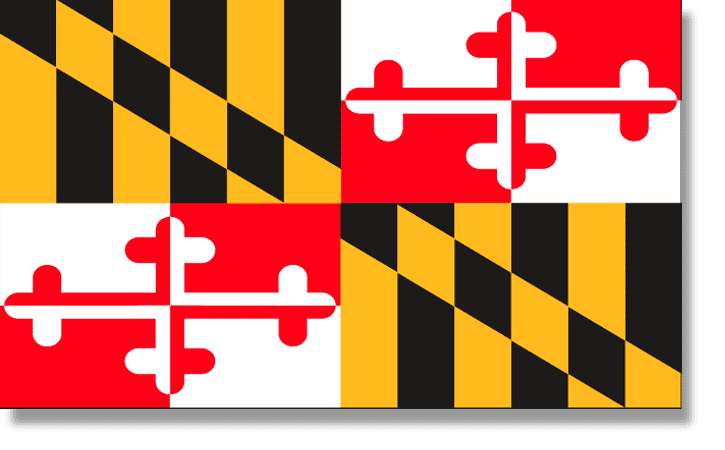
Massachusetts, one of the original 13 colonies of the United States, is one of only two states to have a state flag and a naval and maritime ensign. The original design of the Massachusetts state flag had a design on one side and a green pine tree on a field of white on the back. The pine tree design serves now as the naval ensign. The state flag, approved in its final form, consists of the Massachusetts coat of arms on both sides. On the coat of arms is an Algonquin Native American from the Massachuset tribe, who is carrying a bow and arrow pointing downward in peace. A white star by the figure’s head signifies Massachusetts as the 6th state admitted into the Union. On a blue ribbon around the shield are the Latin words meaning “By the Sword We Seek Peace, but Peace Only under Liberty,” the state motto. This motto is also reflected by the bent arm at the top of the shield holding a broadsword blade
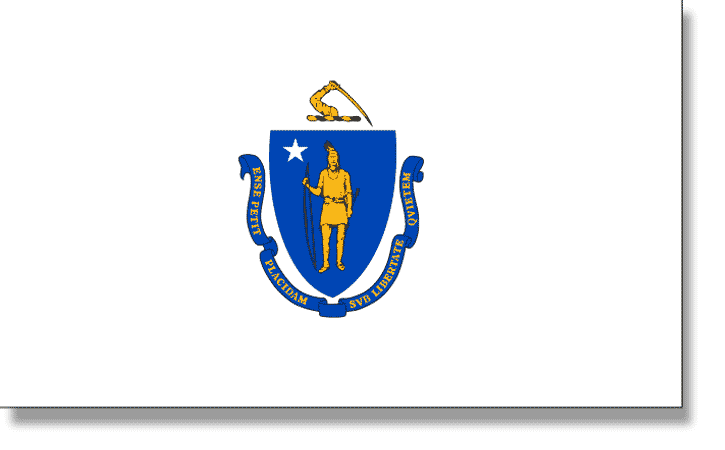
The present flag, adopted in 1911, is the third official flag of the state of Michigan. The first state flag featured Michigan’s first governor, Stevens Thomson Mason, on one side and the Michigan coat of arms on the other. Mason was replaced by the United States coat of arms in the second version in 1865. The present flag consists of the coat of arms on a field of blue as required by Michigan law. The coat of arms features a bald eagle holding an olive branch and arrows on top of a shield, along with a man standing on a grassy peninsula waving with one hand while holding a rifle in the other. The shield is supported by an elk and a moose. Three state mottos encircle the coat of arms, translated from Latin to mean “From many, one”; “I will defend”; and “If you seek a pleasant peninsula, look about you.” The Michigan state flag, with its coat of arms, represents these mottos pictorially
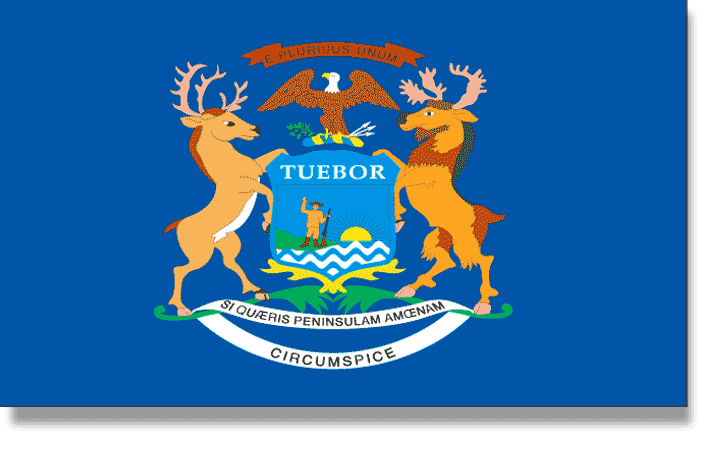
The official flag for the state of Minnesota is made up of the state seal surrounded by a wreath of flowers on a medium blue background. Three dates appear on the wreath: 1858, the year Minnesota became a state; 1819, the year the first settlement at Fort Snelling was established; and 1893, the year the first official flag was adopted. A red ribbon at the top of the seal proclaims the state motto: “L’Etoile du Nord,” French for star of the north. Surrounding the seal is a circular banner containing 19 stars denoting Minnesota as the 19th state to join the union after the original 13 colonies. The largest star, located at the top, represents the North Star, and the word “Minnesota” is located at the bottom. An error in the original flag displaying a wreath of white lady’s slipper flowers, not native to the state, was corrected in 1957. Now the flag displays the pink and white lady’s slipper, the state flower.
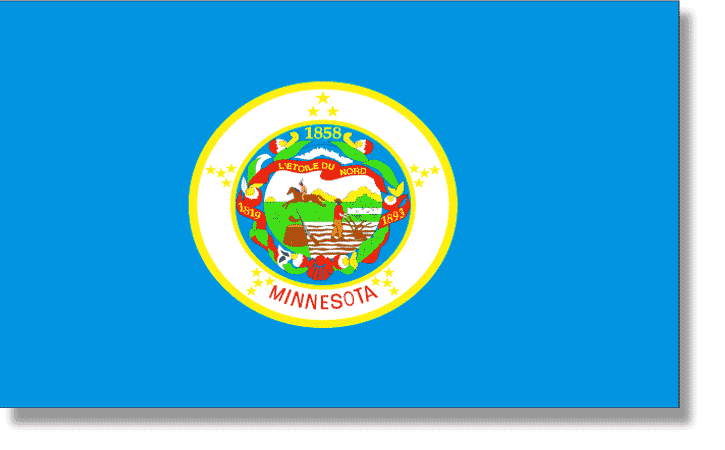
As was the case in neighboring Louisiana, as many as seven different flags of sovereign nations have flown over the territory known now as Mississippi. When Mississippi seceded from the Union, the leaders adopted the Magnolia flag in January of 1861. This design incorporated a magnolia tree on a white field with its canton corner made up of a white star on a blue field (the Bonnie Blue flag). Mississippi became part of the Confederacy in March of that year and flew its flag until the State Legislature adopted its present-day flag in 1894. This flag has the Confederate battle flag in its canton corner (instead of the Bonnie Blue design) with a field made up of equal bars of blue, white, and red at the bottom. In 2001, a proposal to remove the Confederate battle flag was soundly defeated by Mississippi voters, keeping the original design.
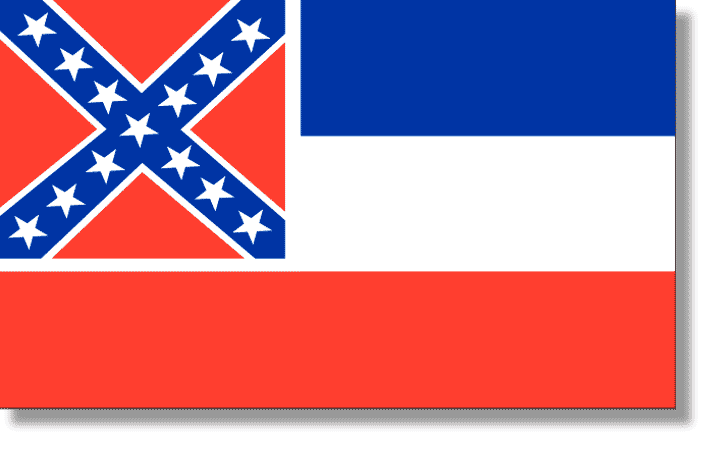
As the second state to be carved from the territory acquired from France in the Louisiana Purchase, Missouri joined the Union as the 24th state in 1820. Like many of its neighboring states, the state of Missouri was deeply divided on the issue of secession. During this troubled time, the state militia carried a flag bearing the Missouri coat of arms showing a Bald Eagle with olive branches (peace) and arrows (war), a grizzly bear, and a crescent moon. On top are the words “United We Stand, Divided We Fall.” Some 92 years later, this shield would become the central feature of a design by Marie Elizabeth Watkins Oliver adopted as the official Missouri State Flag in 1913. On horizontal bars of red, white, and blue (representing its French heritage), the coat of arms is supported by two more grizzly bears standing on a scroll inscribed with the words “Salus populi suprema lex esto” meaning “Let the welfare of the people be the supreme law.” Below the scroll are the Roman numerals for 1820. A band of 24 stars denotes Missouri’s induction into the union.

Copyrights all reserved by Deaf Grassroots Movement
2025